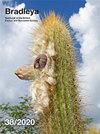栽培仙人掌及其相关种(仙人掌科)记述
IF 1.2
4区 生物学
Q3 PLANT SCIENCES
引用次数: 5
摘要
摘要:对极度濒危物种Perescia quisqueyana Alain(仙人掌科Perescioideae)的两个种子培育个体的形态发育进行了为期五年的研究,并与Leuenbergera G.Rowley P.亚属的其他分类群进行了比较。对来自多米尼加共和国的这个不完全已知但明显相当可变的分类单元进行了补充描述。该物种的遗传多样性表现在有无短梗叶、刺的数量和长度,以及在均匀条件下生长的个体的酚学差异很大。P.subg之间的生长行为和结构差异。Leuenbergera(或Leuenbeergeria属)和P.subg。对Pereskia进行了讨论,得出前者在分支模式上主要是顶声,后者是中声。关于P.aureiflora Ritter,P.bleo(Kunth)DC的形态(包括幼苗)、多胚性、地理范围、生物地理学、生态学、花虫访客、种子传播、用途、具体差异和保护状况的进一步说明。,P.guamacho Weber,P.lychnidiflora DC。和P.portulacifolia(L.)DC。介绍了其大安的列斯盟友,以及在潮湿热带地区种植的带叶仙人掌的一些观察结果。本文章由计算机程序翻译,如有差异,请以英文原文为准。
Notes on cultivated Pereskia quisqueyana and related species (Cactaceae)
Summary: The morphological development of two seed-raised individuals of Pereskia quisqueyana Alain (Cactaceae-Pereskioideae), a Critically Endangered species, was studied in cultivation in Singapore over a period of five years and compared with other taxa from P. subgenus Leuenbergera G. Rowley. An augmented description of this imperfectly known yet evidently rather variable taxon from the Dominican Republic is provided. The genetic diversity of the species manifests itself in the presence or absence of brachyblast leaves, number and length of spines and in wide variations in the phenology of individuals grown under uniform conditions. Growth behavioural and architectural differences between P. subg. Leuenbergera (or genus Leuenbergeria) and P. subg. Pereskia are discussed and it is concluded that the former is largely acrotonic in its branching pattern, the latter mesotonic. Further notes on the morphology (including seedlings), polyembryony, geographic range, biogeography, ecology, flower insect visitors, seed dispersal, uses, specific differences and conservation status of P. aureiflora Ritter, P. bleo (Kunth) DC., P. guamacho Weber, P. lychnidiflora DC. and P. portulacifolia (L.) DC. and its Greater Antillean allies are presented, together with some observations on leaf-bearing cacti in cultivation in the humid tropics.
求助全文
通过发布文献求助,成功后即可免费获取论文全文。
去求助
来源期刊

Bradleya
PLANT SCIENCES-
CiteScore
2.80
自引率
25.00%
发文量
43
审稿时长
>12 weeks
期刊介绍:
Bradleya is the BCSS contribution to the scientific world and is accepted as such because of its academic standards. It can only flourish with the support of BCSS members, many of whom subscribe to it each year. The aim is to include articles which our members will find interesting and educational, whilst retaining rigorous standards of publication. Scientifically important articles don''t have to be dull to read. So, because Bradleya depends the subscriber, the editor endeavours to make its contents accessible, easily understood and enjoyable for all.
 求助内容:
求助内容: 应助结果提醒方式:
应助结果提醒方式:


